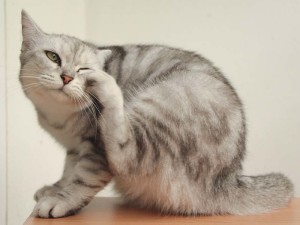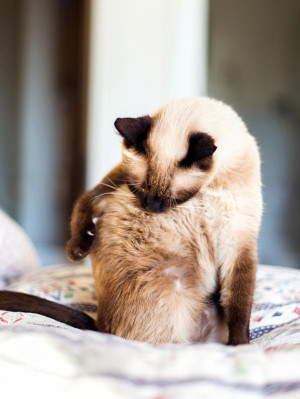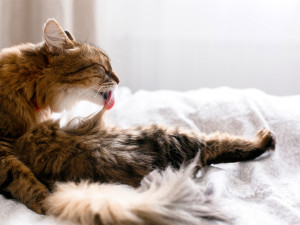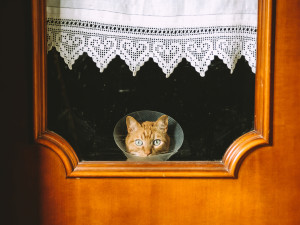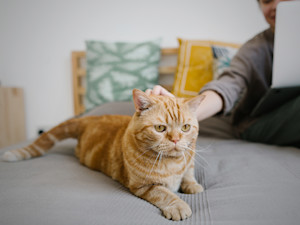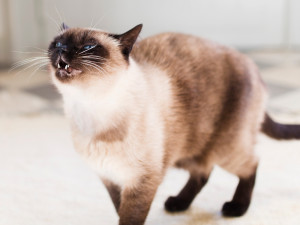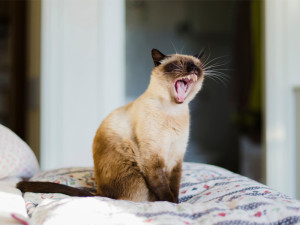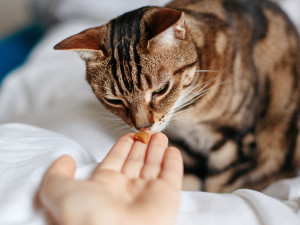Why Does My Cat Have Dandruff? Common Causes and Treatments
Ever heard of “walking dandruff?” Yep, that’s what we said.

Share Article
In This Article:
How to Identify Dandruff in Catsopens in a new tab Common Causes of Dandruff in Catsopens in a new tab How To Get Rid of Dandruff in Catsopens in a new tab Treating Underlying Causesopens in a new tab When to Visit the Vet For Dandruff in Catsopens in a new tab
Cats can develop flaky, dry skin when experiencing external irritants, allergies, hormonal imbalances, or nutritional deficiencies, leading to excessive skin shedding. Fortunately, treating the underlying cause often resolves these issues.

littleKin™ is Kinship’s home just for puppy and kitten parents. Bop over to check out expert advice, new pet tools, and special deals—all curated for your newest family member.
opens in a new tabHow to identify dandruff in cats
Dandruff can appear as white flakes in cat fur, which may cause concern for some cat parents. You might notice these pieces of dry, dead skin along your cat’s spine, the base of their tail, or across their entire body. While dandruff can just be a cosmetic issue that bothers you more than your cat, it could indicate a skin condition or a systemic health problem.
Cat dandruff versus cat dander
Because of the similar-sounding names, some people may confuse cat dandruff with cat dander. Cat dander refers to tiny, microscopic flecks of skin that cats shed during regular activities like grooming. The presence of cat dander is totally normal, but it can get a bad rap because people associate it with human allergies to cats.
People who are allergic to cats are often actually allergic to specific proteins most concentrated in cat saliva, which is spread onto the fur during grooming. Cat dandruff, on the other hand, can be seen with the naked eye, and is not considered to be a normal feature of a healthy cat coat.
Common causes of dandruff in cats
Seborrhea is an overproduction of sebum and can cause skin to be oily and greasy or dry and flaky. Seborrhea sicca is a dry form of seborrhea that involves an excessive loss of the outer layer of skin. Anything that messes with how the skin cells grow or shed can lead to dandruff. Dandruff can be caused by a single issue or a combination of factors.
Reasons why a cat may have a lot of dandruff include:
Poor grooming
Cats have an undercoat — a layer of softer fur that grows close to the skin. Chubby cats may have a hard time reaching every body part to perform proper grooming and keep their coats clean, allowing dirt, oil, and dead skin cells to accumulate in the undercoat. In the same vein, cats with arthritis may not be able to contort themselves in a way that allows proper grooming due to pain.
Going overboard in the opposite direction can also cause issues. Overgrooming and excessive bathing can dry out a cat's skin pretty badly.
Allergies
Food or environmental allergies in cats can manifest as dry, itchy, inflamed skin with lots of dandruff. Cats can be allergic to things like pollen, cigarette smoke, or certain proteins in their diet.
Dry skin conditions
Much like people, cats can develop dry skin and fur under certain conditions. Some cats may just have naturally drier skin. Dry climates or dehydration from low water intake can impact skin and cause dandruff. Drier winter air and central heating can also exacerbate skin dryness.
External parasites
External parasites like fleas and ticks can cause skin irritation that leads to itching and dandruff. Cats that are allergic to flea bites are more prone to developing visible skin changes. Demodex mange — a skin parasite that lives in the hair follicles — can cause thinning of the coat and dandruff as well.
Cat parents who ask, “Why does my cat have so much dandruff… and why is it moving?” may be seeing Cheyletiella mites, which are literally referred to as “walking dandruff.” Cheyletiella mites live on the surface of a cat’s skin and cause excessive flaking. When these mites walk around on the skin, it can sometimes even look like the flakes of skin are moving — hence the name “walking dandruff.”
This condition is called cheyletiellosis and is contagious to other cats, household pets, and humans. So, if you notice “walking dandruff” on your cat, it’s important to see a vet. They can treat the mites, get your cat feeling better, and stop the mites from spreading to other animals or people in your household.
Nutritional deficiencies
To ensure they get all the nutrients they need, every cat should be on a complete and balanced diet that is formulated for felines. A lack of certain vitamins and minerals can lead to dry, flaky skin. Nutritional deficiencies can be due to a lack of intake or poor absorption, like in cases of IBD or other intestinal diseases. Low-fat diets are more likely to contribute to kitty dandruff. Homemade diets can yield similar results.
Endocrine disease
Endocrine (hormonal) conditions can cause feline skin to become thin, dry, and flaky. This can be seen in cats with diabetes mellitus, hyperadrenocorticism (excess blood cortisol), and hypothyroid disease (rare in cats). Dandruff is rarely the first or most significant symptom seen in cats with endocrine disease. These cats often have much more pronounced symptoms like weight fluctuations, appetite changes, and excessive thirst.
How to get rid of dandruff in cats
Dandruff can be a bothersome sight for cat parents. Fortunately, there are several steps you can take to manage your cat's dandruff and keep their coat healthy.
Here are some strategies to remedy cat dandruff:
Treat arthritis pain: Talk to your vet to find out how to manage any pain associated with arthritis opens in a new tabto ensure your cat can move comfortably and groom themselves.
Maintain good nutrition: Ensure a well-balanced diet for your cat to support overall health and coat quality. Cats with food allergiesopens in a new tab often benefit from hypoallergenic diets formulated with novel proteins.
Encourage water intake: Provide ample fresh water to promote healthy, hydrated skin.
Maintain a healthy weight: Provide proper diet and lots of physical activity to help your cat maintain an optimal weight opens in a new tabto ensure their body condition is not a barrier to grooming.
Start a regular grooming routine: Regular brushing can help remove shed hair, distribute oils, and stimulate skin turnover. Bathing with a cat-friendly shampoo specifically formulated to soothe and moisturize a cat’s skin can help reduce dandruff. Don’t overdo it, though — excessive bathing can dry out a cat’s skin. And never use human shampoo because it can cause more irritation and dryness.
Stay on top of parasite prevention: Preventatives help protect cats against parasites like fleas, ticks, and mites that cause skin inflammation and dandruff.
Modify the environment: Use humidifiers, especially in dry winter months, to combat dry air that may contribute to dandruff.
Try topicals: Some cat parents may find success with special sprays, mousses, or wipes developed to help with seborrhea, itching, and dry skin. Be sure only to use products that are made for cats and follow the instructions to a T.
Consider supplements: Over-the-counter omega-3 fatty acid supplementsopens in a new tab can improve coat quality in some pets. Consult with your vet first to ensure that supplements are safe and suitable for your cat’s needs.
Treating underlying causes
Consult with a veterinarian to identify and address any underlying health conditions (l ike diabetesopens in a new tab) that may contribute to your cat’s dandruff. Skin infections may require antibiotics or anti-fungal medications. Systemic diseases like diabetes require long-term management.
When to visit the vet for dandruff in cats
If you notice changes in your cat beyond a little bit of dandruff, a trip to the vet is a good idea. After a physical exam, your vet may recommend blood work, skin cytology, or allergy testing to help rule out possible causes.
Symptoms that call for a vet consult include:
Systemic symptoms: Vomiting, appetite changes, weight loss/gain, and changes in water intake can indicate underlying disease.
Visible external parasites: Parasites like fleas, ticks, and mites should be treated ASAP.
Additional skin problems: Hair loss, redness, itching, scabs, wounds, or foul odor may be signs of skin infection or a condition that requires targeted treatment.
General concern about your cat’s coat: Maybe you’re just a concerned cat parent wanting to know how to maintain your cat’s coat quality — your vet can offer advice.
FAQs (People also ask):
Why does my cat have dandruff on their tail?
The base of the tail can be a tricky spot for some cats to reach for grooming, especially cats that are overweight or have pain from arthritis. A lack of tail grooming can lead to a build up of dandruff.
Why does my black cat have dandruff?
Black cats aren’t more likely to have dandruff than cats with other coat colors; however, dandruff can be way more obvious on black cats, making it seem more common.
Why does my cat have dandruff and hair loss?
Cats can develop dandruff for a variety of reasons, including inadequate grooming, external parasites, low-humidity environments, and systemic disease. Cats with excessive dandruff (especially cats with additional symptoms) should be seen by a vet.
References:
Fel d 1 and Fel d 4 levels in Cat Fur, Saliva, and Urineopens in a new tab
Secondary Scaling Disorders in Dogs and catsopens in a new tab
Feline Dermatology at Cornell University: 1407 Cases (1988–2003)opens in a new tab
Seborrhea: Why and How Does it Happen? — WSAVA Congress Proceedings, 2003

Dr. Alycia Washington, DVM, MS
Alycia Washington, DVM, is a small animal emergency veterinarian based in North Carolina. She works as a relief veterinarianopens in a new tab and provides services to numerous emergency and specialty hospitals. Dr. Washington is also a children’s book author and freelance writer with a focus on veterinary medicine. She has a special fondness for turtles, honey bees, and penguins — none of which she treats. In her free time, Dr. Washington enjoys travel, good food, and good enough coffee.
Related articles
![cat with cone after vet visit]() opens in a new tab
opens in a new tabDoctor’s Orders: Cat Vet Visits Are Essential
Get thy cat to a vet, even if it’s a struggle to get them out the door.
![Owner pets senior ginger cat.]() opens in a new tab
opens in a new tab6 Common Health Concerns in Senior Cats
How to spot and how to treat them.
![A grey cat looking at a dish of fish]() opens in a new tab
opens in a new tabThe 5 Best Fish Oils for Cats
The next best thing to branzino, omega-3s support your cat’s skin, brain, joint, and heart health.
![Siamese cat in the middle of sneeze]() opens in a new tab
opens in a new tabDid Your Cat Just Sneeze Like a Human Being? Here’s Why
Kitty sneezes can be alarming, but they’re not always cause for concern.
![Siamese cat coughing]() opens in a new tab
opens in a new tabWhy Is My Cat Coughing?
You thought it was a hairball, but nothing’s coming up…
![cat being offered a treat or vitamin]() opens in a new tab
opens in a new tabThe Best Supplements and Vitamins for Cat Health
Not your mama’s multivitamin.
